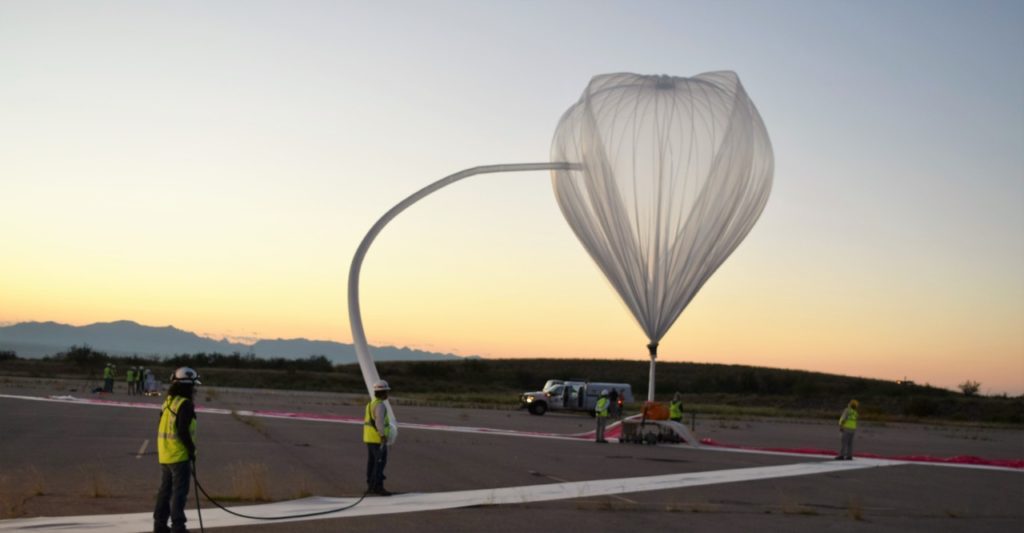World View has successfully completed a high-altitude balloon mission for the Southwest Research Institute, a flight funded by the NASA Flight Opportunities Program (FOP) office.
Southwest Research Institute (SwRI) is one of the oldest and largest independent, non-profit, applied research and development organizations in the United States. For this mission, SwRI flight tested a miniature solar observatory on a five-hour high-altitude balloon flight. The SwRI Solar Instrument Pointing Platform (SSIPP) is a complete, high-precision solar observatory approximately the size of a mini fridge that weighs about 160 pounds. The observatory provides the optical precision equivalent to imaging a dime from a mile away.
World View launched the flight out of Benson Municipal Airport at 6:05am PT on Saturday, September 3rd, 2016. The World View launch operations team, led by Launch Director and Chief Engineer Sebastian Padilla, coordinated with all local, regional, national and government authorities to ensure a safe and seamless mission operation. The flight reached a peak altitude of just over 31km, with total flight duration lasting just over five hours. The payload and balloon were both safely returned to earth following the flight, and were recovered by World View personnel.
The solar observatory itself collects solar data using infrared, ultraviolet, or visible light instruments. The SwRI scientists used the observatory to search for high-frequency solar soundwaves. The unique frequency of these “solar ultrasound” waves makes them undetectable by ground-based observatories, but detectable after being lofted above the majority of Earth’s atmosphere via a World View balloon. These this experiments prove the efficacy of a new generation of low-cost solar observatory platforms that can enable researchers to regularly image the solar atmosphere to better understand its heat and noise properties.
“This novel, low-cost prototype was developed for less than $1 million, which is one-tenth of the cost of comparable balloon-borne observatories,” said Principal Investigator Dr. Craig DeForest, a scientist in SwRI’s Space Science and Engineering Division. This breaks down traditional barriers to science by allowing a low-cost platform for solar research.
This flight wasn’t World View’s first for the NASA FOP office. Over the past few years, World View has conducted a number of NASA funded high-altitude balloon missions, all from launch locations in Arizona. World View was also recently awarded two new NASA FOP contracts to conduct high-altitude balloon missions funded by the agency. Those flights are planned to launch in the near future from Tucson, AZ or a nearby municipality.
World View is an approved NASA FOP commercial spaceflight services provider. Under the Flight Opportunities Program, NASA selects promising new space technologies from industry, academia, and government and links them with U.S. commercial spaceflight companies to provide the researchers access to relevant environments for flight testing. This helps NASA mature technology payloads for future space missions while simultaneously fostering growth in the commercial space industry.
World View offer a unique perspective of Earth from the edge of space. via two primary business segments: Stratollite un-crewed flight systems and Voyager human spaceflight systems, in development. Stratollites, offer low-cost, long-duration, persistent high-altitude flight for enterprise and government agencies. Using advanced stratospheric balloon technology, Stratollite applications include communications, remote sensing, weather, and research.

World View Completes Successful NASA Flight Mission. credits: World View Enterprises
Source: World View Inc.

















































































































![A trajectory analysis that used a computational fluid dynamics approach to determine the likely position and velocity histories of the foam (Credits: NASA Ref [1] p61).](http://www.spacesafetymagazine.com/wp-content/uploads/2014/05/fluid-dynamics-trajectory-analysis-50x50.jpg)



Leave a Reply